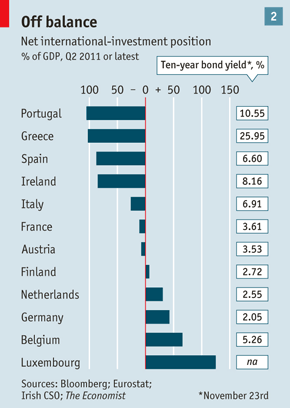Economists are increasingly recognizing the Euro Area problems as a balance-of-payments crisis, in addition to realizing that the Euro Area national governments cannot finance their deficits by making a draft at the Eurosystem in extreme emergency.
The Economist has an article today Beware of falling masonry with the graph on the net asset position which I posted on several occasions in this blog.
With a few exceptions, the benchmark cost of credit in each euro-zone country is related to the balance of its international debts. Germany, which is owed more than it owes, still has low bond yields; Greece, which is heavily in debt to foreigners, has a high cost of borrowing (see chart 2). Portugal, Greece and (to a lesser extent) Spain still have big current-account deficits, and so are still adding to their already high foreign liabilities. Refinancing these is becoming harder and putting strain on local banks and credit availability.
The higher the cost of funding becomes, the more money flows out to foreigners to service these debts. This is why the issue of national solvency goes beyond what governments owe. The euro zone is showing the symptoms of an internal balance-of-payments crisis, with self-fulfilling runs on countries, because at bottom that is the nature of its troubles. And such crises put extraordinary pressure on exchange-rate pegs, no matter how permanent policymakers claim them to be.
The magazine also had another nice article recently: Is this really the end?. Here is a collection of covers from the magazine in recent times on the Euro.
